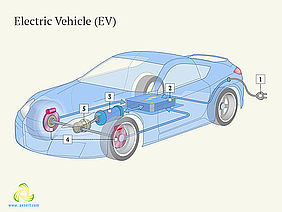In the search for a vehicle battery able to extend the driving range of electric vehicles scientists have tried to exchange the currently-used graphite anodes with lithium metal anodes. Lithium can extend an EV’s driving range by 30–50%, but also shortens the battery’s useful life. This is due to dendrites and their needle-like projections called whiskers that can grow inside a lithium battery and impair its proper functioning because they can pierce the separator inside the battery. They also increase unwanted reactions between the electrolyte and the lithium, speeding up battery failure.
Now (2020), scientists at Berkeley Lab have designed a new class of soft, solid electrolytes made from both polymers and ceramics that are able to suppress dendrites in early stage of nucleation, before they can cause battery failure. To build these new electrolytes, scientists used soft polymers of intrinsic microporosity (PIMs), whose pores were filled with nanosized ceramic particles. To research the dendrite-suppressing features of the new PIM composite electrolyte, the team used X-rays to create 3D images of the interface between the lithium metal and the electrolyte and also to analyse lithium plating and stripping for up to 16 hours at high current. The result was that lithium showed smooth growth when the new PIM composite electrolyte was present, while in its absence the interface exhibited telltale signs of the early stages of dendritic growth. These and other data confirmed the predictions gained through a new physical model for electrode position of lithium metal, which takes into account both chemical and mechanical characteristics of the solid electrolytes. These insights allowed the scientists to extend the life cycle of the cell, even when assembled with thin Li anodes (~30 µm) and either high-voltage NMC-622 cathodes (1.44 mAh cm−2) or high-capacity sulfur cathodes (3.02 mAh cm−2).
For many years scientists have tried to find methods and materials allowing them to improve the efficiency as well as life of batteries. In 2014, scientists investigated a catalyst electrode, where discharge products were deposited and decomposed, and also investigated an electrode design principle to improve specific capacity and cycling performance of lithium-oxygen batteries by utilizing high efficiency nanocatalysts assembled by M13 virus with earth abundant elements, such as manganese oxides. By incorporating only 3–5 wt % of palladium nanoparticles in the electrode, this hybrid nanocatalyst achieved 13,350 mAh g−1c (7,340 mAh g−1c+catalyst) of specific capacity at 0.4 A g−1c and a stable cycle life up to 50 cycles at 1 A g−1c.
In 2015, scientists discovered that when the three-dimensional amorphous silicon polymers poly (methylsilyne) and poly (phenylsilyne) were used as anode materials, dendritic Li formation on the anode surface was avoided up to a practical current density of 10 mA·g−1 at 5 °C. They also found that poly (methylsilyne) and poly (phenylsilyne) was able to react with 0.45 and 0.9 Li atoms per formula unit, respectively, at an average voltage of approximately 1.0 V, affording reversible capacities of 244 mAh·g−1 and 180 mAh·g−1. One of the advantages of this approach was that polysilynes are suitable for practical applications because they can be prepared through a simple and low-cost process and are easy to handle.
In 2016, scientists employed a two-layered cathode produced by a simultaneous slot-die coating method to improve battery life. The composition in each layer was made up of different proportions of two conductive additives: one with a high percentage of micro-sized graphite, and the other with a high percentage of nano-sized carbon black. Of the four cell structures, the two-layered cathode with an upper layer having more carbon black and a lower layer having more graphite particles exhibited the best current discharge capacity and longer life cycle, which could have potential applications in new LIBs design.
There are several advantages to this new technology: solid-state energy storage technologies such as solid-state lithium metal batteries, which use a solid electrode and a solid electrolyte, can provide high energy density combined with increased safety, but the technology must overcome diverse materials and processing challenges. Because the electrolyte is a flexible, soft, solid material, battery manufacturers will be able to manufacture rolls of lithium foils with the electrolyte as a laminate between the anode and the battery separator. These lithium-electrode sub-assemblies (LESAs) could be useful drop-in replacements for the conventional graphite anode, which would make it possible for battery manufacturers to use their existing assembly lines.
This new dendrite-suppressing technology has promising implications for the battery industry because with it battery manufacturers can produce safer lithium metal batteries with both high energy density and a long life cycle.
